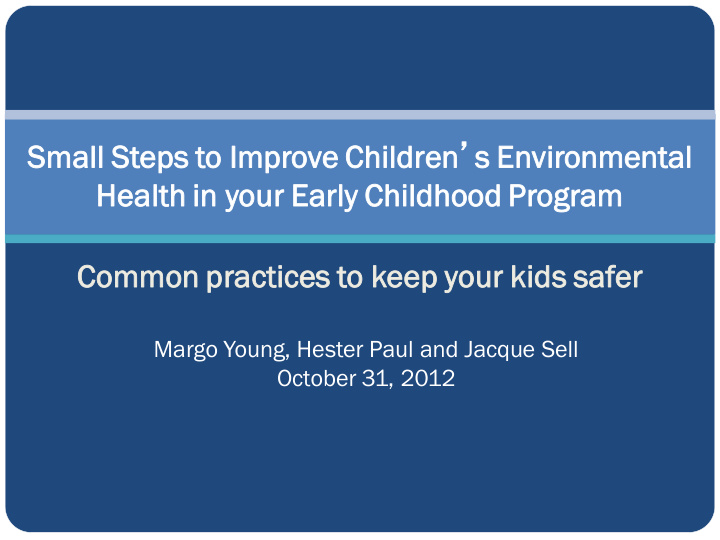



Small Steps s to Improve ve Childr dren ’ s s Environ onment ntal al Health h in yo your Early y Childho hood od Program am Common on practices to keep yo your kids safer Margo Young, Hester Paul and Jacque Sell October 31, 2012
Learning Objectives Discover why children are more vulnerable to environmental exposures Identify environmental hazards in child care settings Learn how to reduce these hazards and achieve recognition for running an Eco-Healthy child care Learn how other child care centers have been “ greened ” and where to find resources for more information 2
This s is what envir ironm onmen ent t looks s like 3
Other Toxic Chemicals 80,00 ,000 0 on the TSCA A inventor ory A child born in America today will grow up exposed to more chemicals than a child from any other generation in our history. Lack ck of data and testing for new ew and A 2005 study found 287 different ex exis isting ing chemica icals chemicals in the cord blood of 10 newborn babies – chemicals from pesticides, fast food packaging, coal and gasoline emissions, Restrict iction ions s on just 5 and trash incineration. chemica cals ls 4
Child Care in the United States People spend about 90% of their time indoors Indoor air pollution levels can be 2-5 times greater than outdoors Nearly 11 million children in child care No universal policies on environmental safety for child care facilities Opportunities for “greening” child cares and providing critical information to parents 5
You can make a difference! With so many children spending so much time in child care centers, you can impact the children you care for Good environmental health and high quality child care helps children reach their full potential 6
Where could you find these hazards? Opportunities for Exposure: Pests and Lead and Pesticides Mercury Mold and Radon, Chemicals, Moisture CO, ETS VOCs 7
Key Environmental Hazards Lead and other heavy metals Pests and pesticides Plastics BPA phthalates Building materials Asbestos Formaldehyde Flame retardants Indoor air contaminants Second-hand smoke VOCs Cleaning products Asthma triggers 8
Children Are Not Little Adults 9
Body Differences Drink, eat, and breathe more than adults, as based on body weight Children are rapidly growing and developing Less developed natural defenses More skin per pound and less protective skin Chemicals in the womb and in breast milk 10
Behavioral Differences • Natural explorers • Spend more time close or on the ground and floors • Spend more time outdoors than adults • Mouthing behaviors • Place dirty fingers and objects in their mouth • Ingest dirt and dust, which may be contaminated 11
Health Disparities All children are susceptible to negative outcomes as a result of environmental exposures, but they disproportionately affect minorities and children living below the poverty level Brain Disorders Asthma Cancer 12
Asthma: Outcomes and Disparities 7 million kids suffer from asthma 2 million emergency room visits annually 13 million missed school days annually Black children are two times as likely to be hospitalized, four times as likely to die from asthma as white children 13
Brain Disorders: Outcomes and Disparities Exposure to certain chemicals can lead to ADHD, lowered IQ, autism spectrum disorders, behavioral disorders and/or developmental delays 12 million U.S. children, or 17%, have learning or behavioral disabilities Chemical exposures play a role in at least 1 in 4 cases of behavioral or developmental disorders ADHD is more common in children below the poverty level 14
Cancer Cancers: second cause of death among children (ages 1 -14 years of age) Approximately 10,400 U.S children under age 15 diagnosed with cancer in 2007 Cancers may not appear until many years after the exposure(s) to cancer-causing chemicals have taken place 15
You can make a difference! With so many children spending so much time in child care centers, you can impact the children you care for Good environmental health and high quality child care helps children reach their full potential 16
Resources: EPA and its Partners Office of Children’s Health Protection [epa.gov/children] EPA Healthy Child care website [epa.gov/childcare] EPA subject matter experts (lead and other heavy metals, indoor air, hazardous chemicals, pests and pesticides, etc.) Regional children’s health coordinators Training and Outreach PEHSUs [http://www.aoec.org/pehsu.htm] 17
Resources: epa.gov/childcare 18
EPA Regional Offices Kathleen Nagle Nagle.kathleen@epa.gov LaTonya Sanders 617-918-1985 Sanders.latonya@epa.gov 913-551-7555 Alicia Aalto Aalto.alicia @epa.gov Maryan n Suero Suero.maryann@epa.gov 303-312-6867 312-886-9077 Margo Young Young.margo@epa.gov 206-553-1287 Maureen O’Neill Oneill.maureen@epa.go Kathleen Stewart 212-637-5025 Stewart.kathlkeen@epa.goc 415-947-4119 Prentiss Ward Ward.prentiss@epa.gov 215-814-2813 Wayne Garfinkel Garfinkel.wayne@epa.gov 404-562-8982 Paula Selzer Selzer.paula@epa.gov 19 214-665-6663
PEHSUs Co-funded by EPA and ATSDR Provide education and consulting services -- information and advice on pediatric environmental health issues to clinicians, health care professionals and the community 10 PEHSUs provide nationwide coverage Fact sheets on “hot” issues and ad hoc answers to questions from the public http://www.aoec.org/pehsu.htm 22
23
Thank you! Margo Young www.epa.gov/children Regional Children’s Health www.epa.gov./childcare Coordinator www.epa.gov/schools young.margo@epa.gov www.epa.gov/region10/children 206-553-1287 25
Recommend
More recommend